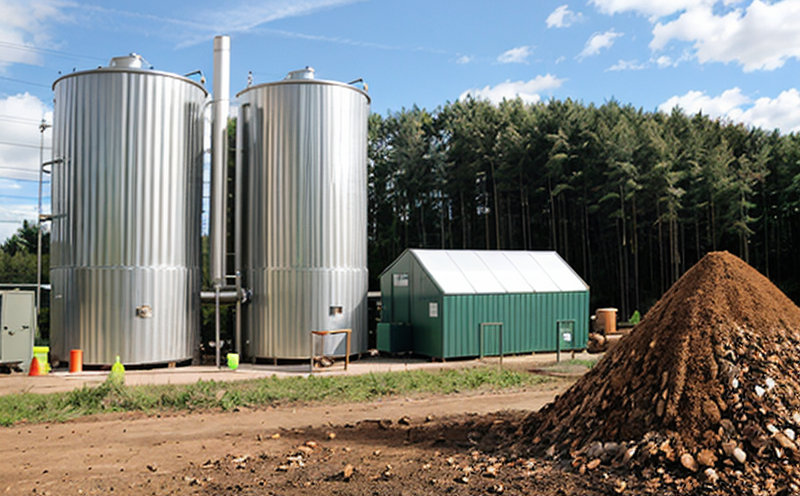ASTM E897 Density of Waste-to-Energy Biomass Fuels
The ASTM E897 standard provides a method to determine the apparent and true density of waste-to-energy (WtE) biomass fuels. This service is essential for ensuring that WtE fuels meet specified quality standards, which are critical for efficient processing and conversion into energy. The process involves precise measurement techniques to ensure accurate determination of fuel properties.
Accurate density measurements play a crucial role in the waste management sector by helping optimize the feedstock used in WtE processes. This is particularly important as the industry moves towards more sustainable practices. Understanding the true and apparent densities helps in optimizing combustion efficiency, reducing emissions, and ensuring compliance with regulatory requirements.
The ASTM E897 standard ensures that the density of biomass fuels is accurately determined under controlled conditions. This service supports waste management professionals, R&D teams, and compliance officers by providing reliable data on fuel characteristics. The measurements help in selecting optimal feedstock for different WtE processes, thereby enhancing overall operational efficiency.
The testing procedure involves preparing samples according to ASTM E897 guidelines. Samples are conditioned to ensure consistent moisture content, which is a critical factor affecting density measurements. Once prepared, the samples undergo two stages of density determination: apparent and true density. Apparent density measures the mass per unit volume of the sample as it exists in its natural state, while true density accounts for the internal voids within the biomass.
The ASTM E897 method also includes considerations for particle size distribution and moisture content, which significantly impact the final density readings. Understanding these parameters ensures that the test results are reflective of real-world conditions where the fuel will be used. This detailed approach is vital for accurate quality control and process optimization in WtE facilities.
Accurate density measurements ensure that waste-to-energy processes operate efficiently, leading to better conversion rates and reduced environmental impact. The service supports compliance with regulatory standards by providing precise data on fuel characteristics. This information is crucial for R&D teams working on improving conversion technologies or optimizing existing processes.
| Applied Standards |
|---|
| ASTM E897-23 |
By adhering to these standards, the service ensures consistency and reliability in density measurements. This is particularly important as the WtE industry continues to grow, with increasing demands for sustainable fuel sources.
Applied Standards
The ASTM E897 standard is designed to provide a comprehensive and reliable method for determining the density of waste-to-energy biomass fuels. This standard ensures that the testing process adheres to internationally recognized protocols, providing consistent results across different laboratories.
The procedure outlined in ASTM E897 involves several key steps, including sample preparation, conditioning, and measurement under controlled conditions. The test measures both apparent and true density of the fuel samples, which are critical for understanding their physical characteristics and potential performance in WtE processes.
By following these standardized procedures, laboratories can ensure that they produce accurate and reliable data, which is essential for effective waste management and recycling practices. This standard also supports the development of new technologies by providing a consistent reference point for research and development teams.
Scope and Methodology
The ASTM E897 method covers the determination of apparent and true density of waste-to-energy (WtE) biomass fuels. This includes both solid and pelletized materials, as well as other forms that are typically used in WtE processes. The standard provides detailed procedures for sample preparation, conditioning, and measurement under controlled conditions.
Sample preparation is a critical step in the testing process. It involves conditioning the samples to ensure consistent moisture content, which directly affects the density measurements. This includes drying or humidifying the samples as necessary to bring them to a standard condition. The sample preparation ensures that the test results are representative of the actual fuel characteristics.
Once prepared, the samples undergo two stages of density determination: apparent and true density. Apparent density measures the mass per unit volume of the sample in its natural state, while true density accounts for internal voids within the biomass. This distinction is important because it reflects the different ways in which fuel characteristics impact WtE processes.
The ASTM E897 method also includes considerations for particle size distribution and moisture content, both of which are critical factors affecting density measurements. Understanding these parameters ensures that the test results are reflective of real-world conditions where the fuel will be used. This detailed approach is vital for accurate quality control and process optimization in WtE facilities.
Benefits
- Ensures compliance with regulatory standards by providing precise data on fuel characteristics.
- Supports the development of new technologies by offering a consistent reference point for research and development teams.
- Aids in optimizing feedstock selection for different WtE processes, enhancing overall operational efficiency.
The ASTM E897 method provides several benefits to laboratories and waste management professionals. By ensuring that fuel samples are accurately measured under controlled conditions, this service supports compliance with regulatory standards. This is crucial for maintaining consistent quality in the production of waste-to-energy fuels.
The precise density measurements provided by this service also support R&D teams working on improving conversion technologies or optimizing existing processes. Accurate data helps these teams make informed decisions about feedstock selection and process optimization, ultimately leading to more efficient WtE facilities.
In addition to supporting compliance and R&D efforts, the ASTM E897 method aids in optimizing feedstock selection for different WtE processes. By providing reliable data on fuel characteristics, this service helps waste management professionals select optimal feedstock that maximizes conversion efficiency while minimizing environmental impact. This supports the overall goal of sustainable waste management practices.





